Lohri
| Lohri | |
|---|---|
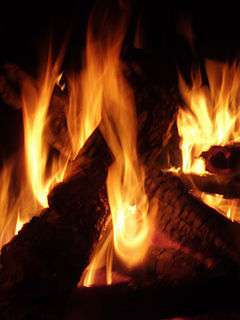 Lohri Bonfire | |
| Also called | Lal Loi |
| Observed by | Multi cultural |
| Type | Seasonal, traditional |
| Significance | Midwinter festival, celebration of Winter Solstice |
| Celebrations | Bonfire, song and dance (Bhangra and Gidda ) |
| Date | 13 January (Punjabi calendar) |
| Related to |
Sankrant Pongal Bihu (Bhogali / Magh /Bhogi in Telugu) |
Lohri (Gurmukhi: ਲੋਹੜੀ, Devanagari: लोहड़ी, Shahmukhi: لوہڑی) is a popular Punjabi festival,[1][2] celebrated by people from the Punjab region of South Asia.[3] The origins of Lohri are many and link the festival to Punjab region.[4] Many people believe the festival commemorates the passing of the winter solstice[5] as Lohri was originally celebrated on winter solstice day,[6] being the shortest day and the longest night of the year.[7][8]
Lohri and winter solstice
Origins
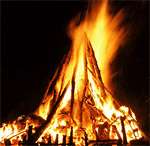
There are many origins of Lohri: all forming part of folklore. However, the main theme of Lohri is the belief that Lohri is the cultural celebration of the winter solstice.[9][10] Lohri is meant to be celebrated on the shortest day of the year.
According to folk lore, in ancient times Lohri was celebrated on winter solstice day.[11][12] It is for this reason that people believe the Lohri night is meant to be the longest night of the year and on the day after Lohri, day light is meant to increase. Accordingly, the day after Lohri is celebrated as Maghi Sangrand when the days are meant to start getting longer.[13][14] People believe nights gradually shorten "by the grain of one sesame seed" once the winter solstice passes.[15]
However, instead of celebrating Lohri on the day winter solstice occurs,[16] Punjabis celebrate it on the last day of the month during which winter solstice takes place. This is due to linking Lohri to the Bikrami calendar and the twinning of the festival with Makar Sankranti which is celebrated in the Punjab region as Maghi Sangrand.[17] Therefore, Lohri commemorates the passing of the winter solstice.[18]
Scientifically, the shortest day of the year is around 21–22 December after which the days begin to get longer. Accordingly, winter solstice begins on 21 December or 22 December and Lohri ought to be celebrated on the day of winter solstice followed by Maghi (Makar) Sangrand the next day.
Bonfire
.jpg)
A key feature of Lohri is the bonfire. Lighting of the fire has been common in winter solstice festivals throughout time and the world:[19][20] it signifies the return of longer days.[7] The bonfire is an ancient tradition,[13] forming a key part of Lohri traditions.[21][22][23][24][25]
Seasonal festival
Punjabis continue to practice their Punjabi folk religion. Respect to the seasons and the natural elements of fire, wind, water and the earth is very important. In the Punjab region, the year is divided into six seasons. The Punjabi months of Maghar and Poh represent the "hemant" season when Winter is at its height. Lohri is celebrated on the last day of Poh and therefore, is a festival dedicated to the end of the Winter season,[9][13] whereas Teej (known as Teeyan in Punjabi) is dedicated to the rain/Monsoon season and Basant Festival is dedicated to the Spring season. Lohri is a Punjabi festival celebrated by all faiths of the Punjab region.[26]
Lohri and harvest festival
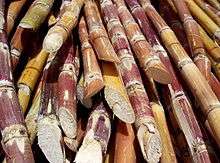
Lohri is traditionally associated with the harvest of the rabi crops.[27] The traditional time to harvest sugarcane crops is January[28] and therefore, Lohri is seen by some to be a harvest festival. The general time to sow sugarcane is January to March and the harvesting period is between December to March with a 12 to 18-month cycle.[29] Sugarcane products such as gurh and gachak are central to Lohri celebrations, as are nuts which are harvested in January [30] The other important food item of Lohri is radish which can be harvested between October and January.
Lohri and the new year

Punjabi farmers see the day after Lohri (Maghi) as the financial new year. It is a very important day. The farmers celebrate Lohri as such. New agricultural tenancies commence on Lohri and rents are collected on this day.[9]
Date
As Lohri has been linked to the Bikrami calendar, the festival has been twinned with the astrological festival of Maghi celebrated in the rest of India as Makar Sankranti. Other cultures observe winter solstice as per its original meaning (see winter solstice).
Lohri falls in the month of Paush i.e. around 13 January, as per the Gregorian calendar. It is, actually, celebrated a day before Maghi, as it marks the end of the winter season of hemant in the Punjabi calendar. The sun usually enters the Nirayana Makara rashi (Capricorn) on 14 January (99% of the time). However, there are times when the sun could enter the zodiac a day before or a day after 14 January. Regardless, Lohri is still celebrated a day before Maghi. Makara (Maghi) sankranti (Sangrand) marks beginning of the solar maagha masa, and Lohri must be celebrated on the last day of the solar Dhanur masa, which also marks the exit of the sun from Dhanu rashi (Sagittarius).
For the general latitude and longitude of Punjab, 13 January represents the day after which sunrise occurs progressively earlier in the morning, till about 10–12 June. After these days in June, sunrise begins to occur progressively later in the morning till about 10–12 January. Therefore, the celebration of lohri on 13 January every year coincides with the shift from a progressively later sunrise to a progressively earlier sunrise.
Food
_Jaggery_Gud_Punjab_India.jpg)

It is traditional to eat Gajak, Sarson da saag with Makki di roti, radish, ground nuts and jaggery.[31] It is also traditional to eat "til rice" which is made by mixing jaggery, sesame seeds and rice.[32]
Collecting Lohri items and trick or treating
In various places of the Punjab, about 10 to 15 days before Lohri, groups of young and teenage boys and girls go around the neighbourhood collecting logs for the Lohri bonfire. In some places, they also collect items such as grains and jaggery which are sold and the sale proceeds are divided amongst the group.[13]
A popular activity engaged in by boys is to select a group member to smear his face with ash and tie a rope around his waist! The idea is for the selected person to act as a deterrent for people who refrain from giving Lohri items. The boys will sing Lohri songs asking for Lohri items. If not enough is given, the householder will be given an ultimatum to either give more or the rope will be loosened. If not enough is given, then the boy who has his face smeared will try to enter the house and smash clay pots or the clay stove!.[13]
Dulla Bhatti
Over time, people have associated Lohri to the tale of Dulla Bhatti.[33] The central theme of many Lohri songs is the legend of Dulla Bhatti, who lived in Punjab during the reign of Mughal Emperor Akbar. He was regarded as a hero in Punjab. Besides robbing the rich, he rescued poor Punjabi girls, being forcibly taken to be sold in slave market of the Middle East from the Sandal Bar region. He arranged their marriages to boys and provided them with dowries. Amongst them were two girls Sundri & Mundri(married in 1614) who gradually became theme of Punjab' folklore. So some Lohri songs express gratitude to Dulla Bhatti.
Ceremony
During the day, children go from door to door singing folk songs. These children are given sweets and savories, and occasionally, money. Turning them back empty-handed is regarded inauspicious. Where families are welcoming newly-weds and new borns,[34] the requests for treats increases.[13]
The collections gathered by the children are known as Lohri and consist of til, gachchak, crystal sugar, gur (jaggery), moongphali (peanuts) and phuliya or popcorn. Lohri is then distributed at night during the festival. Till, peanuts, popcorn and other food items are also thrown into the fire.
The bonfire ceremony differs depending on the location in Punjab. In some parts, a small image of the folk Lohri goddess is made with gobar (cattle dung) decorating it, kindling a fire beneath it and chanting its praises. The folk Lohri goddess is believed to be an ancient aspect of the celebration,[13] and is part of a long tradition of Winter solstice celebrations manifesting as a god or goddess.[35] In other parts, the Lohri fire consists of cow dung and wood with no reference to the Lohri goddess.
The bonfire is lit at sunset in the main village square. People toss sesame seeds, gur, sugar-candy and rewaries on the bonfire, sit around it, sing and dance till the fire dies out. Some people perform a prayer and go around the fire. This is to show respect to the natural element of fire,[36] a tradition common in winter solstice celebrations. It is traditional to offer guests til, gachchak, gur, moongphali (peanuts) and phuliya or popcorn. Milk and water is also poured around the bonfire by Hindus. This ritual is performed for thanking the Sun God and seeking his continued protection.
Among some sections of the Sindhi community, the festival is traditionally celebrated as Lal Loi. On the day of Lal Loee children bring wood sticks from their grand parents and aunties and light a fire burning the sticks in the night with people enjoying, dancing and playing around the fire. The festival is gaining popularity amongst other Sindhis where Lohri is not a traditional festival.[37]
Kite flying
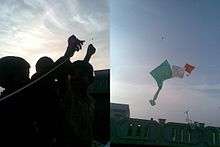
Kite flying on Lohri is popular in some parts of Punjab. People get onto the roof tops and fly kites of various sizes and colours. [38]
Celebrations
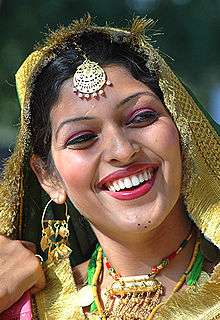



Lohri is celebrated to denote the last of the coldest days of winter. Apart from Punjab, people from other northern Indian states of the Punjab region (Haryana, Delhi, Himachal Pradesh), Chandigarh and Jammu become busy making preparations for Lohri. The festival is observed as Lal Loi in the Sindhi community.[39][40][41][42]
In houses that have recently had a marriage or childbirth, Lohri celebrations will reach a higher pitch of excitement. Punjabis usually have private Lohri celebrations, in their houses. Lohri rituals are performed, with the accompaniment of special Lohri songs.
Singing and dancing form an intrinsic part of the celebrations. People wear their brightest clothes and come to dance the bhangra and gidda to the beat of the dhol. Punjabi songs are sung, and everybody rejoices. Sarson da saag and makki di roti is usually served as the main course at a Lohri dinner. Lohri is a great occasion that holds great importance for farmers. However, people residing in urban areas also celebrate Lohri, as this festival provides the opportunity to interact with family and friends.
Lohri songs
There are many Lohri songs. For example, the following song which has words to express gratitude to Dulla Bhatti (the 'ho's are in chorus):[43]
Sunder mundriye ho!
Tera kaun vicharaa ho!
Dullah Bhatti walla ho!
Dullhe di dhee vyayae ho!
Ser shakkar payee ho!
Kudi da laal pathaka ho!
Kudi da saalu paata ho!
Salu kaun samete!
Chacha gali dese!
Chache choori kutti! zamidara lutti!
Zamindaar sudhaye!
Bum Bum bhole aaye!
Ek bhola reh gaya!
Sipahee far ke lai gaya!
Sipahee ne mari itt!
Bhaanvey ro te bhaanvey pitt!
Sanoo de de Lohri, te teri jeeve jodi!
(Laugh,cry or howl!)
Translation
Beautiful girl
Who will think about you
Dulla of the Bhatti clan will
Dulla's daughter got married
He gave one ser of sugar!
The girl is wearing a red suit!
But her shawl is torn!
Who will stitch her shawl?!
The uncle made choori!
The landlords looted it!
Landlords are beaten up!
Lots of simple-headed boys came!
One simpleton got left behind!
The soldier arrested him!
The soldier hit him with a brick!
(Cry or howl)!
Give us Lohri, long live your pair (to a married couple)!
Whether you cry, or bang your head later!
Other legends of the origin of Lohri festival
Some people believe that Lohri has derived its name from Loi, the wife of Saint Kabir. There is a legend amongst some people that Lohri comes from the word 'loh', which means the light and the warmness of fire. Lohri is also called lohi in rural Punjab.[44] According to another legend Holika and Lohri were sisters. While the former perished in the Holi fire, the latter survived with Prahlad. Eating of til (sesame seeds) and rorhi is considered to be essential on Lohri day. Perhaps the words til and rorhi merged to become tilorhi, which eventually got shortened to Lohri.
Other parts of India
Lohri coincides with the festivals of Pongal, Bhogali Bihu and Bhogi.
In Andhra Pradesh, the day preceding Makara Sankranti is called Bhogi (భోగి) and this is when people discard old and derelict things and concentrate on new things causing change or transformation. At dawn people light a bonfire with logs of wood, other solid-fuels and wooden furniture at home that are no longer useful. The disposal of derelict things is where all old habits, vices, attachment to relations and material things are sacrificed in the sacrificial fire of the knowledge of Rudra, known as the "Rudra Gita Gyana Yagya". It represents realization, transformation and purification of the soul by imbibing and inculcating divine virtues.
Festivals in other countries
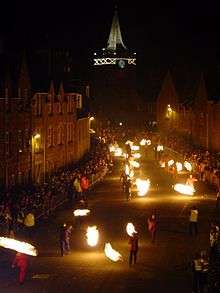
Winter solstice festivals have been incorporated into other festivals which are celebrated in various regions around the world. The festival of Yule is observed during Christmas celebrations whereby a log is burnt to commemorate the winter solstice.
The festival of Hogmanay is celebrated on new year’s day. The fire festival of Stonehaven in Scotland is the direct descendant of lighting winter solstice bonfires.[20][45] Another event is observed every 11 January when the flaming Clavie (a barrel full of staves) is carried round in Burghead and is wedged on the Doorie Hill. When it is burnt out, people take the smouldering embers to bring good luck for the coming year.[46][47]
See also
References
- ↑ A WHITE TRAIL:A JOURNEY INTO THE HEART OF PAKISTAN’S RELIGIOUS MINORITIES Haroon Khalid
- ↑ Bishop Joseph Arshad Lohri festival
- ↑ Asian News Jan 2013: Lohri celebrated in Faislabad, Punjab, Pakistan
- ↑ Khushwant Singh The Telegraph 24 01 2004
- ↑ Tribune Magic of astro-festivities by Rajesh Kochar 19 July 1998
- ↑ The Tribune Festival binge: Amarjot Kaur 10 January 2015
- 1 2 http://www.purewal.biz/Holamu.pdf
- ↑ Celebrating with the Robin Hood of the Punjab and all his friends! Nottingham Post 13 01 2014
- 1 2 3 Singh, Hazara: Seasonal Festivals and Commemorative Days. Publisher: Hazara Singh Publications
- ↑ India TV News Know why Lohri, the bonfire festival, is celebrated 13 01 2014
- ↑ The Hindu 07 01 2013
- ↑ Hindustan Times 12 01 2013
- 1 2 3 4 5 6 7 Sundar mundarye ho by Assa Singh Ghuman Waris Shah Foundation ISBN B1-7856-043-7
- ↑ Daily Mail 13 01 2012
- ↑ Times of India Bella Jaisenghami 11 January 2015
- ↑ With Bonfires And Dancing, Indians Ring In Hindu New Year by Julie Mccarthy 15 01 2014
- ↑ Some people believe Makar Sankranti is also meant to be celebrated on winter solstice day. This needs to be researched as Makar Sankranti celebrates when day light increases, which happens on the day following the winter solstice. However, if this is the case, Lohri will need to be celebrated a night before as Makar Sankranti is celebrated a day after Lohri.
- ↑ Hindustan Times 12 January 2015 Snigdha Ahuja
- ↑ The History of Hogmanay Ben Johnson
- 1 2 http://stonehavenfireballs.co.uk/about
- ↑ Page 17: From Kartik month the Sun is moving away from the earth. Ancient people lit the bonfire to reignite the return of longer days. This is a very ancient tradition. Sundar mundarye ho by Assa Singh Ghuman Waris Shah Foundation ISBN B1-7856-043-7
- ↑ Makar Sankranti signifies Uttarayana which occurs after the winter solstice. Lohri is celebrated a day before Makar Sankranti which signifies winter solstice.
- ↑ NDTV 06 12 14
- ↑ NDTV 14 01 13
- ↑ According to some, Makar Sankranti is meant to be celebrated on winter solstice day but this needs investigating as Makar Sankranti marks the start of Uttaraya which is a day after winter solstice
- ↑ Chauhan, Ramesh K. (1995) Punjab and the nationality question in India. Deep and Deep Publications.
- ↑ Shivani Vig The Times of India 13/01/2010
- ↑ Toby Sinclair 25 10 2012
- ↑ http://agrocommodities.wordpress.com/sugar/sugarcane-growth-cycleindia/
- ↑ http://www.faidelhi.org/general/statistics/sowing.htm
- ↑ Tribune Harvinder Khetal 12 January 1999
- ↑ Sundar Mundarye ho by Assa Singh Bhuman Waris Shah Foundation ISBN 81-7856-043-7
- ↑ "Origin of Lohri".
- ↑ Times of India Soudamini Mujumdar 14 01 2015
- ↑ http://paganwiccan.about.com/od/yulethelongestnight/a/Winter_Sol_Gods.htm
- ↑ FirozBakht Ahmed Deccan Herald 18/01/2010
- ↑ Nidhin Singhi Times of Indis 13 01 2012
- ↑ Hindustan Times by Vandana SIngh 09 01 2014
- ↑ http://www.theindianpanorama.news/potpourri/spirituality/lohri-the-bonfire-festival-3.html
- ↑ http://www.dailyexcelsior.com/lohri-aaye-rey/
- ↑ http://www.scoopnews.in/det.aspx?q=53555
- ↑ http://scroll.in/article/801803/lohri-legends-the-tale-of-abdullah-khan-dullah-bhatti-the-punjabi-who-led-a-revolt-against-akbar
- ↑ "Dhulla Bhatti Song".
- ↑ Faith & Philosophy of Sikhism, Harjeet Singh
- ↑ http://www.historic-uk.com/HistoryUK/HistoryofScotland/The-History-of-Hogmanay/
- ↑ http://www.burghead.com/clavie.html
- ↑ the Magic Arts in Celtic Britain Lewis Spence
Lohri Poems 2016 Harvest season Top Songs
External links
- Why we can celebrate Lohri Festival ?
- Origin of Lohri
- Panchang to find exact date of sun's entry into makara

